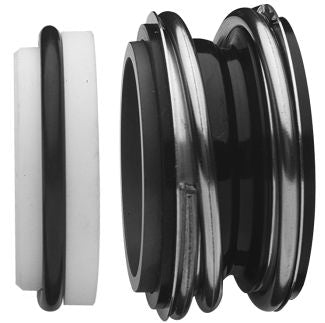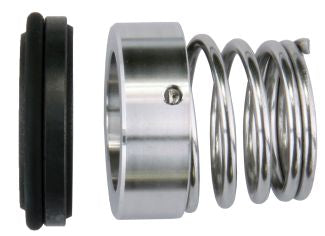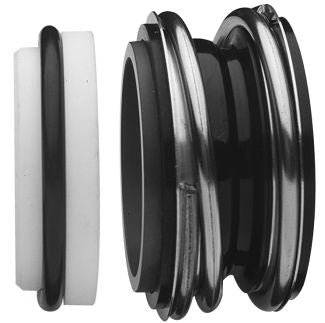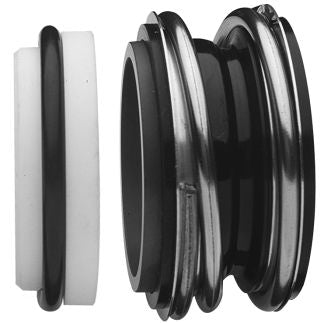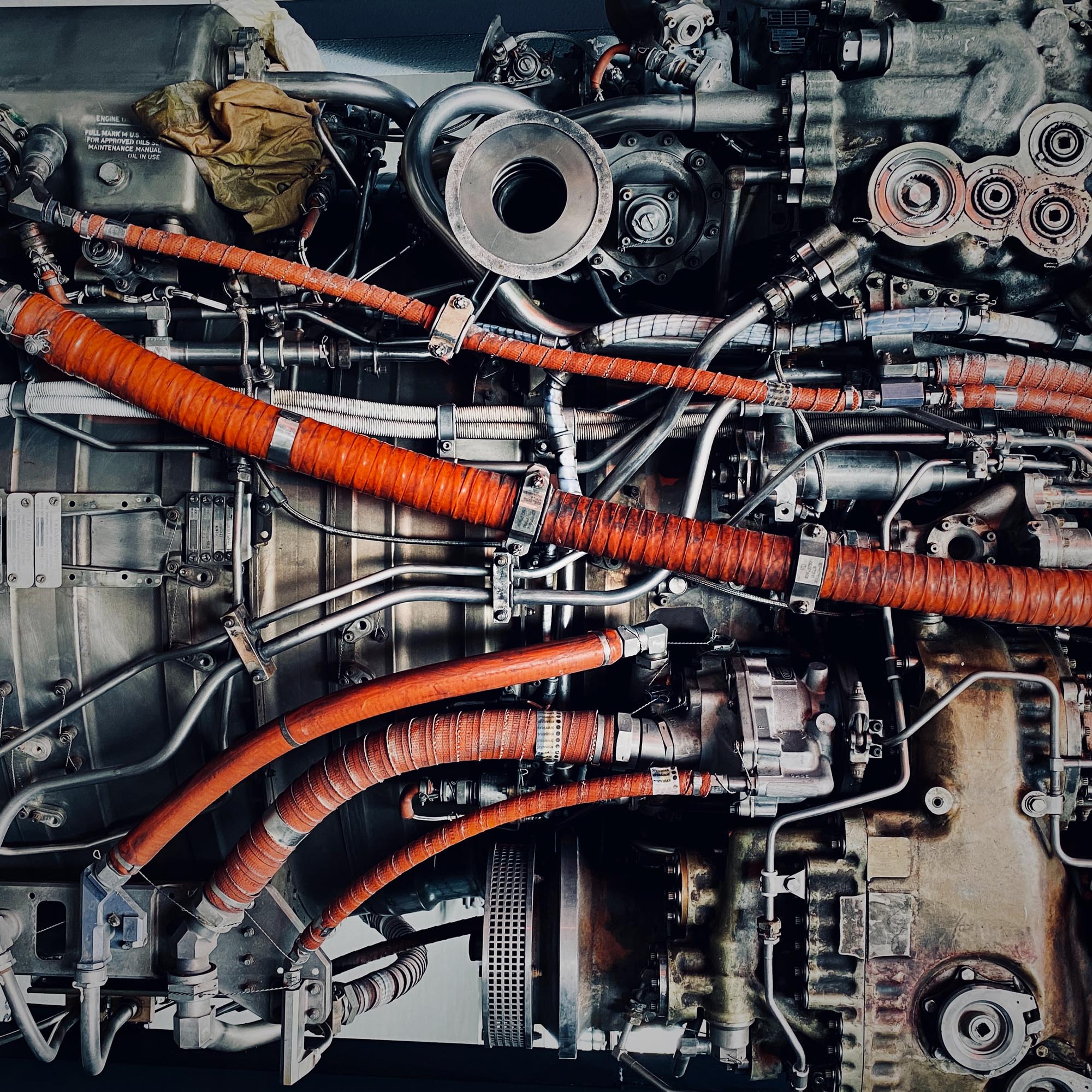
The basics of Mechanical Seals
How do Mechanical Seals work?
Mechanical seals are essential components used to create a sealing face in systems where a rotating shaft protrudes from or into a housing. These systems may be filled with fluids or be under pressure, and the seal must maintain the rotating action while ensuring reliability. While there are slight variations in design, the general principle of how mechanical seals work remains consistent. Here is a step-by-step explanation:
1. Contact
The sealing action begins with the contact between the rotating and stationary faces. These faces are pressed together by the spring force within the seal assembly. This force is critical for creating an initial seal and maintaining contact between the faces, even as the shaft rotates. The stationary face remains fixed within the housing, while the rotating face moves with the shaft.
2. Lubrication
As the shaft rotates, a thin film of fluid forms between the seal faces. This fluid film plays a crucial role in reducing friction and wear between the rotating and stationary faces. It provides lubrication that helps to minimize heat generation and prevent damage to the sealing surfaces. The film also aids in maintaining a consistent seal by accommodating slight misalignments and movements.
3. Sealing
The primary function of the mechanical seal is to prevent the fluid or gas from escaping between the rotating shaft and the stationary housing. The spring force and fluid film work together to ensure that the seal faces remain in contact, effectively sealing the gap and preventing leakage. This sealing action is maintained even under varying pressures and operational conditions, ensuring the reliability and efficiency of the equipment.
Traditional vs. Mechanical Seals
Traditionally, gland packing was used to achieve a seal in systems with rotating shafts. However, in higher specification machinery, mechanical seals are necessary due to their superior performance and reliability. Mechanical seals offer several advantages over gland packing, including better sealing efficiency, reduced maintenance, and longer service life.
Mechanical seals operate by maintaining contact between the rotating and stationary faces through spring force, utilizing a lubricating fluid film to reduce friction and wear, and effectively sealing the gap to prevent leakage. These principles ensure that mechanical seals can provide reliable performance in a wide range of industrial applications.
See a mechanical seal in action in our 2 minute video
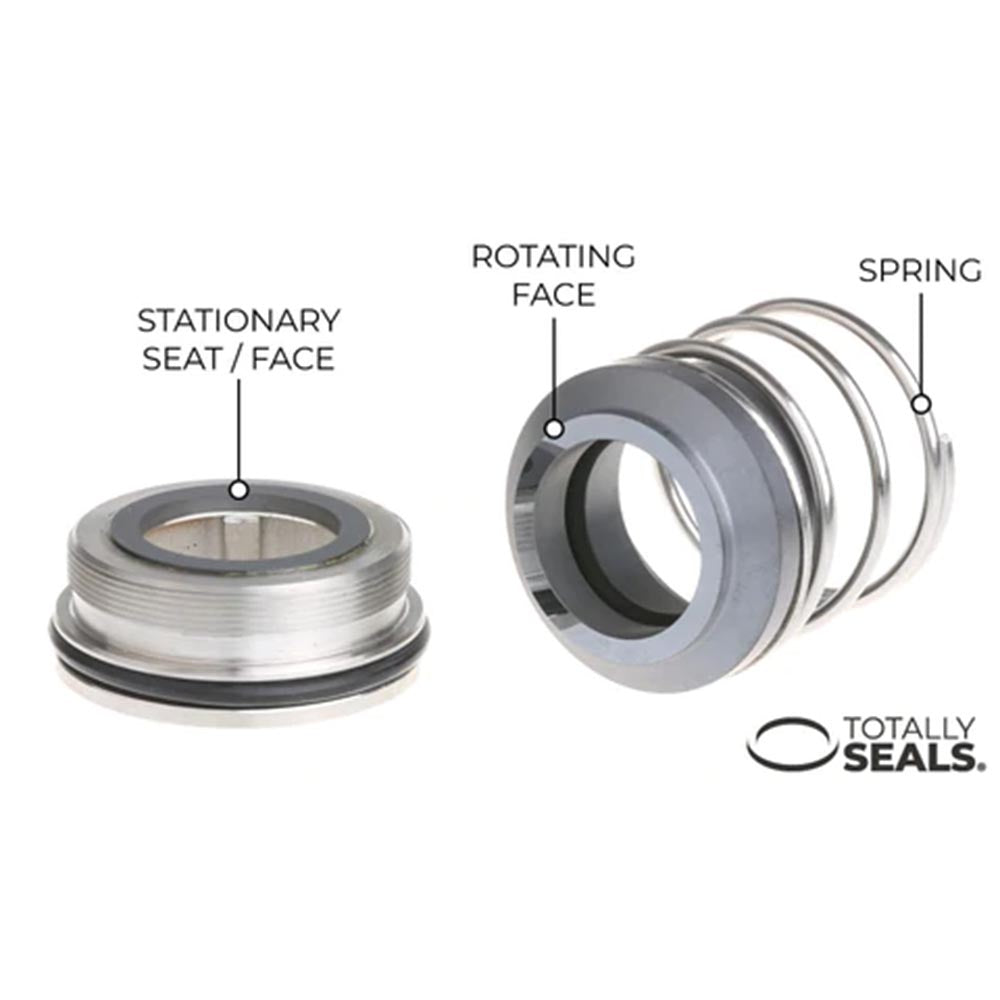
The 3 main parts of a mechanical seal
In a regular mechanical seal, there are three basic mechanisms working to maintain the seal; the stationary seat/face, the rotating face and the spring.
Ensuring these parts meet the requirements for it's intended use is key to getting the perfect seal.
Benefits of Using Mechanical Seals
Mechanical seals offer several advantages over traditional sealing methods, making them a preferred choice for many applications:
Leak Prevention
Mechanical seals are highly effective at preventing fluid and gas leakage, ensuring that systems operate safely and efficiently without environmental contamination.
Durability
Designed to withstand harsh operating conditions, mechanical seals are made from high-quality materials that provide long-lasting performance, even in demanding environments.
Efficiency
By maintaining a tight seal and reducing friction, mechanical seals improve the efficiency and reliability of equipment, leading to better performance and lower energy consumption.
Reduced Maintenance
Mechanical seals require minimal maintenance compared to other sealing methods. Their robust design and reliable performance help minimise downtime and reduce maintenance costs.
Versatility
Mechanical seals are suitable for a wide range of applications and industries, including chemical processing, oil and gas, food and beverage, and water treatment. Their adaptability makes them a versatile solution for various sealing needs.
Types of Mechanical Seals
Selecting the right mechanical seal for your application involves understanding the different types available and their typical uses. Here are the main types of mechanical seals and their common applications:
-
Conical Spring
Conical spring seals feature a single conical spring that provides the necessary load on the seal faces. They are simple in design and easy to install and maintain. These seals are ideal for residential, commercial, and agricultural water pumping systems, commonly used in heating, ventilation, and air conditioning (HVAC) equipment, and suitable for moderate pressures and temperatures in light-duty applications.
-
Elastomeric Bellows
Elastomeric bellows seals utilise a flexible elastomeric bellow to compensate for misalignment and axial movement. Their clog-resistant design makes them suitable for a variety of fluids. They are used in hygienic applications in the food and beverage industry where easy cleaning is essential, effective in sewage and wastewater treatment plants, and commonly used in water pumps and oil handling systems.
-
Parallel Spring
Parallel spring seals use multiple parallel springs to evenly distribute the load across the seal faces, ensuring reliable performance under varying conditions. These seals are used in chemical processing to handle corrosive and hazardous chemicals, suitable for pumps and compressors in oil refineries and gas plants, and effective in high-pressure environments where durability is crucial.
-
Multiple Springs
Multiple springs seals employ multiple springs to provide a uniform load, enhancing the seal’s reliability and performance in demanding applications. They are ideal for handling aggressive chemicals in chemical processing, used in processes involving various solvents and chemicals in pharmaceutical manufacturing, and suitable for high-corrosion environments where standard materials would degrade.
-
Wave Spring
Wave spring seals utilise wave springs to create a compact design with consistent load distribution, making them ideal for confined spaces and high-efficiency applications. These seals are effective in high-temperature systems, used in critical systems requiring reliable sealing under extreme conditions in aerospace and defence, and suitable for high-pressure environments in the petrochemical industry.
-
Water Pump Seals
Specifically designed for water pump applications, water pump seals are optimised for durability and performance in water-handling systems. They are used in residential and commercial water supply systems, ideal for irrigation and water management systems in agriculture, and suitable for use in municipal water systems in cities and towns.
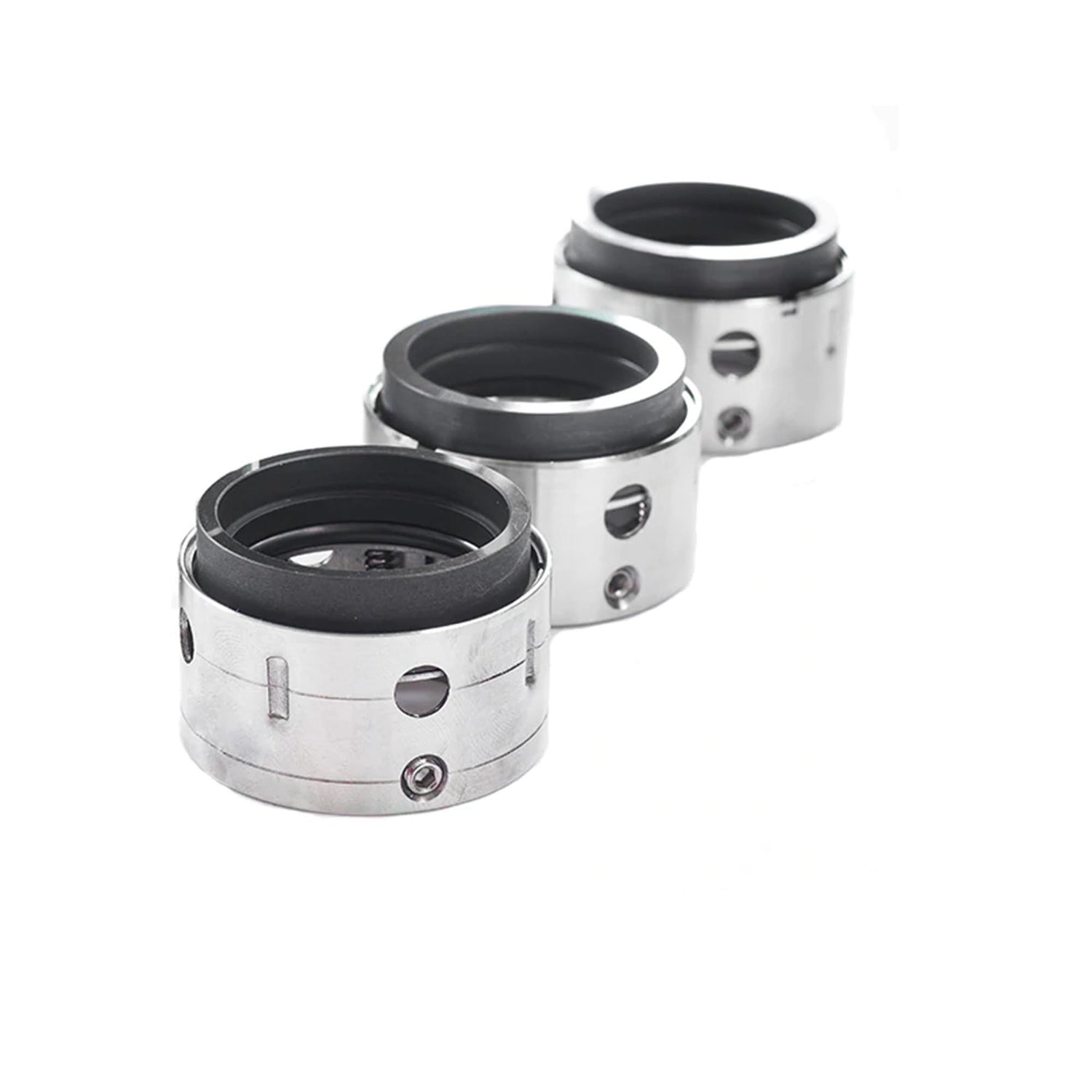
The main types of Mechanical Seals
Mechanical Seals come in many types, with endless variations, to meet the varying requirements of each equipment or machine.
The 4 most common types of mechanical seals are; Rubber Diaphragm, Rubber Bellows, O-Ring Mounted & PTFE Wedge.
Take a closer look at these seal types and how they work.
Maintenance and Troubleshooting
Proper maintenance and timely troubleshooting are essential for the optimal performance and longevity of mechanical seals. Here are some tips:
Regular Inspection
Conduct regular inspections to check for signs of wear, leakage, and misalignment. Early detection of issues can prevent more significant problems and extend the seal's life.
Proper Installation
Ensure correct installation to avoid premature failure. Follow manufacturer guidelines and use appropriate tools and techniques to achieve a secure and effective seal.
Lubrication
Maintain adequate lubrication to reduce friction and wear between the seal faces. Proper lubrication helps maintain a thin fluid film, which is crucial for seal performance.
Troubleshooting Common Problems
- Leakage: Check for worn or damaged seal faces, misalignment, or inadequate lubrication.
- Excessive Wear: Inspect for abrasive particles in the fluid, improper installation, or excessive pressure.
- Noise: Look for misalignment, improper lubrication, or worn components.
By following these maintenance and troubleshooting tips, you can ensure that your mechanical seals provide reliable and efficient performance, minimizing downtime and extending the life of your equipment.
FAQs on Mechanical Seals
What are the signs of a failing mechanical seal?
Several indicators can suggest a mechanical seal is failing, including:
- Leakage: Visible fluid or gas escaping from the seal area.
- Excessive Noise: Unusual sounds such as squealing or grinding coming from the seal.
- Heat Generation: Increased temperature around the seal, indicating friction and wear.
- Vibration: Excessive shaft vibration can signal seal misalignment or wear.
- Corrosion: Signs of corrosion or pitting on the seal components.
How often should mechanical seals be replaced?
The replacement frequency of mechanical seals depends on several factors:
- Application: Seals in harsh environments or critical applications may require more frequent replacement.
- Operating Conditions: High pressures, temperatures, and corrosive media can reduce seal life.
- Maintenance: Regular inspection and maintenance can extend the life of a seal.
- Seal Type and Quality: High-quality seals generally last longer than lower-quality alternatives.
As a general guideline, seals should be inspected regularly, and any signs of wear or damage should prompt replacement.
Can mechanical seals be repaired?
In some cases, mechanical seals can be repaired, especially if the damage is minor. Repairs might include:
- Replacing Worn Faces: Changing out the seal faces that have worn down.
- Reconditioning: Polishing or re-lapping seal faces to restore flatness.
- Replacing Secondary Seals: Swapping out O-rings, gaskets, or bellows that have degraded.
However, for severe damage or critical applications, it is often safer and more cost-effective to replace the entire seal assembly.
What factors affect the lifespan of a mechanical seal?
Several factors can impact the lifespan of a mechanical seal:
- Operating Conditions: Extreme pressures, temperatures, and the presence of abrasive or corrosive substances can shorten seal life.
- Installation Quality: Proper installation ensures optimal performance and longevity.
- Material Selection: Choosing the right materials for the application can enhance durability and resistance to wear.
- Maintenance Practices: Regular inspection, cleaning, and timely repairs can extend the life of a seal.
- Operational Variability: Fluctuations in operating conditions, such as sudden pressure spikes or temperature changes, can stress the seal and reduce its lifespan.
For optimal performance, it's essential to select the appropriate seal type for your application, install it correctly, and maintain it regularly.
Order before 2pm to get same day dispatch next day delivery
Ready to discuss your mechanical seal requirement?
Our expert team are on hand to help you.
Our Mechanical Seals range
We can supply replacement seals for most major manufacturers: Eagle Burgmann, John Crane, Roten/Uniten, AES, Alfa Laval, Grundfos, MTU, PAC-Seal, US Seal and more.
Our most popular mechanical seals
-
Burgmann MG12 Equivilant Mechanical Seal
Regular price From £117.19 GBPRegular priceUnit price / per -
Roten Type 2 Equivalent Mechanical Seal
Regular price From £117.19 GBPRegular priceUnit price / per -
Burgmann MG1 Equivilent Mechanical Seal
Regular price From £117.19 GBPRegular priceUnit price / per -
Burgmann MG13 Equivilant Mechanical Seal
Regular price From £117.19 GBPRegular priceUnit price / per
Need help finding your perfect seal?
-
Identify the seal you need
Use toolOur Mechanical Seal Idenitifcation tool can help you indentify the seal you need by selecting the key design features.
-
Know your material
View guideOur Mechanical Seals Materials Guide can tell you which material will give you the perfect seal.
-
Check Chemical Compatibility
Check materialsFind the perfect material for your requirements by it's compatibility with the chemical you need to seal.

